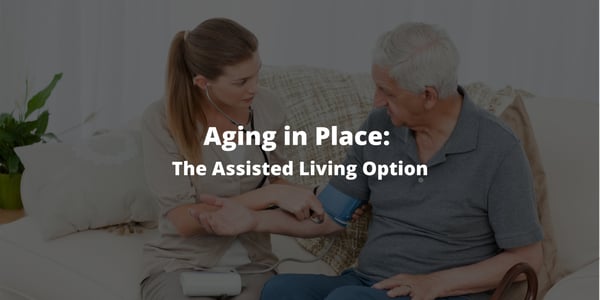The majority (76%) of those over 50 say they would prefer to continue living in their own...
Is In-Home Care Right for Me?
A common assumption persists that "senior living" means residing in a skilled nursing, assisted living, or memory care facility. In fact, the vast majority (96%) of adults 65 and older live in the community (homes or apartments). The motivation to "age in place" at home has a lot of appeal. An AARP study found that 90% of older U.S. adults want to stay in their homes as long as possible. The reasons for this are:
- More independence
- Familiar surroundings and routines
- Established relationships
- Lower living expense
- Avoid the cost of moving
However, as people age, the potential for needing assistance increases as the incidence of physical and mental problems grows. This threatens the ability to age in place because the older adult needs the support of caregivers.
The Caregivers
Caregiving in the U.S. falls mainly to family members. A 2015 report by AARP and the National Alliance for Caregiving reported that of the 34.2 million Americans who served as unpaid caregivers to older adults, 86% provided care to a relative.
While this can be an economical and comfortable way to go, caregiving can be stressful. Caregivers are usually women, and if those women also need to care for children and hold a job, the stress can be considerable. Also, unpaid caregivers may not be trained or able to provide all the necessary care. For example, incorrectly lifting or otherwise moving a limited-mobility adult can risk injury to both the caregiver and the patient.
The In-Home Healthcare Option
An option for continuing to age in place at home is professional in-home healthcare. In this scenario, a business provides trained staff to deliver healthcare in the home.
Home healthcare services can be found for various situations.
Personal Care
 Personal care involves help with ADLs and day-to-day needs to remain safe and independent. This kind of care can include:
Personal care involves help with ADLs and day-to-day needs to remain safe and independent. This kind of care can include:
- Helping with bathing, dressing, grooming, and using the toilet
- Moving an older adult from place to place around the house and preventing falls
- Support for meals, housekeeping, laundry, errands, medication reminders, and appointments
- Supervising a person with Alzheimer's disease or other dementia-related conditions
Personal care may only be needed at certain times of the day, although 24-hour care may be required for some seniors. It is important to note that the people delivering this care are typically not certified to administer medication.
The Personal Care option may also be as simple as being a companion for a lonely individual who is otherwise independent. In-home care may also allow family caregivers to get a break and avoid burnout.
Private Nursing
Private nursing applies to patients with more acute medical needs. Services can include:
- Administering medications
- Monitoring vital signs
- Care of catheters, feeding tubes, ostomy/gastrostomy, tracheostomy care, or a ventilator
- Physical, speech, or occupational therapy
Depending on the condition's severity, licensed and certified caregivers may be on duty 24 hours per day.
Short-Term Healthcare
When an older adult has an illness or medical procedure requiring recovery time, medical professionals may order in-home healthcare services for the patient. Services may include any of those mentioned above in the Personal Care and Private Nursing categories, depending on the nature and severity of the older adult's condition. Assistance may be needed around the clock or just occasionally. By definition, this type of care is short-term rather than permanent. The providers of the more medically intensive care must be licensed and certified.
In-Home Healthcare Costs
 Some might assume in-home healthcare costs less than residing in a senior living facility. However, the cost depends on the number of services needed daily and the hours required to deliver those services.
Some might assume in-home healthcare costs less than residing in a senior living facility. However, the cost depends on the number of services needed daily and the hours required to deliver those services.
For example, the cost of an assisted living facility in the U.S. averages $4,300 per month. If an older adult needs daily help for only an hour or two at an average of $24/hour, then in-home healthcare would be more cost-effective. However, if in-home assistance were required 24 hours a day, the monthly cost would be over $17,000.
For more intensive services, the monthly cost of a skilled nursing facility is, on average, $7,513 for a double occupancy room and $8,517 for a single-occupancy room. In-Home health care again would be more affordable if 11 hours or less per day were required.
How to Pay?
Paying for In-Home Healthcare can come from various sources.
Medicare
Medicare will pay for doctor-ordered Short-Term Healthcare, but long-term healthcare is not covered.
Medicare will cover Personal Care services only if they are delivered along with prescribed medical services. Also, some Medicare Advantage policies may cover types of Personal Care. Still, each policy provider is different, so it pays to understand the details.
Medicaid
Medicaid will pay for in-home care for seniors who qualify on both medical and financial grounds. Personal Care is covered in some states, but only care delivered by licensed professionals is covered in others. Researching a state's particular Medicaid rules is essential to understanding what is covered for a specific individual.
Long-term Care Insurance
Long-term care insurance often covers in-home care. However, some older policies lack this type of coverage. Also, coverage may not apply unless the policy beneficiary reaches a certain level of disability. So, it makes sense to check existing policies for specific in-home care provisions.
Veterans Aid and Attendance Benefit
Veterans may be able to tap the VA Aid and Attendance benefit to fund in-home care. To qualify, veterans must be receiving a VA pension and meet additional eligibility requirements. Some veterans may also need a doctor's letter confirming a disability to receive Aid and Attendance.
Reverse Mortgage Loans
Reverse mortgages allow a homeowner to leverage the equity of a home to access non-taxable cash. This allows older adults to have the money for in-home healthcare without having to sell the home. There are many critical angles to consider when taking out a reverse mortgage. Still, they can be an excellent way to pay for in-home healthcare.
Private Pay
As a last resort, seniors can pay out of pocket for in-home healthcare. This is the most common way people pay for in-home care.
How to Choose an In-Home Care Provider
Here are some questions to ask when evaluating an in-home care provider.
 How long has your business been serving this community?
How long has your business been serving this community?- What services do you offer, and how much does each cost?
- How are caregivers trained in these services? What ongoing training do they receive?
- How do you ensure that caregivers are appropriately trained and credentialed?
- Is your business licensed in this state?
- Is your liability insurance current?
- Can you provide reviews/references?
- What is the track record for caregivers showing up on time?
- What is the backup plan if caregivers cannot make it at the scheduled time?
- What insurance, if any, do you accept?
- Do you provide a "Patient Bill of Rights"?
- Do nurses or therapists evaluate the patient's home care needs and provide a care plan?
- How do the patient and family members participate in developing the care plan?
- How are changes made in the care plan, and how are those changes communicated?
- Is the patient's treatment documented with specific details of tasks carried out by each caregiver?
- Do the patient and family have access to this documentation?
- Do caregivers educate the patient and family on the care being delivered?
- How do supervisors keep tabs on the quality of care for patients?
- Whom can the patient and family members call with questions or complaints?
- How does the provider follow up on and resolve problems?
- Does the provider furnish written financial statements explaining the costs and payment plans?
- What procedures does the care provider have in place to handle emergencies?
- How does this provider ensure patient confidentiality?
Although there are many details to consider, in-home healthcare may be an excellent way for older adults to stay safe and healthy as they age in place at home.
Visit our Long-term Care Resources page for more helpful content about planning for care!






![How Your Home Can Help Pay for Long-Term Care [Video]](https://7364579.fs1.hubspotusercontent-na1.net/hub/7364579/hubfs/Plain%201024x512/Copy%20of%20How%20Your%20Home%20Can%20Help%20Pay%20for%20Long-Term%20Care.jpg?width=600&name=Copy%20of%20How%20Your%20Home%20Can%20Help%20Pay%20for%20Long-Term%20Care.jpg)


